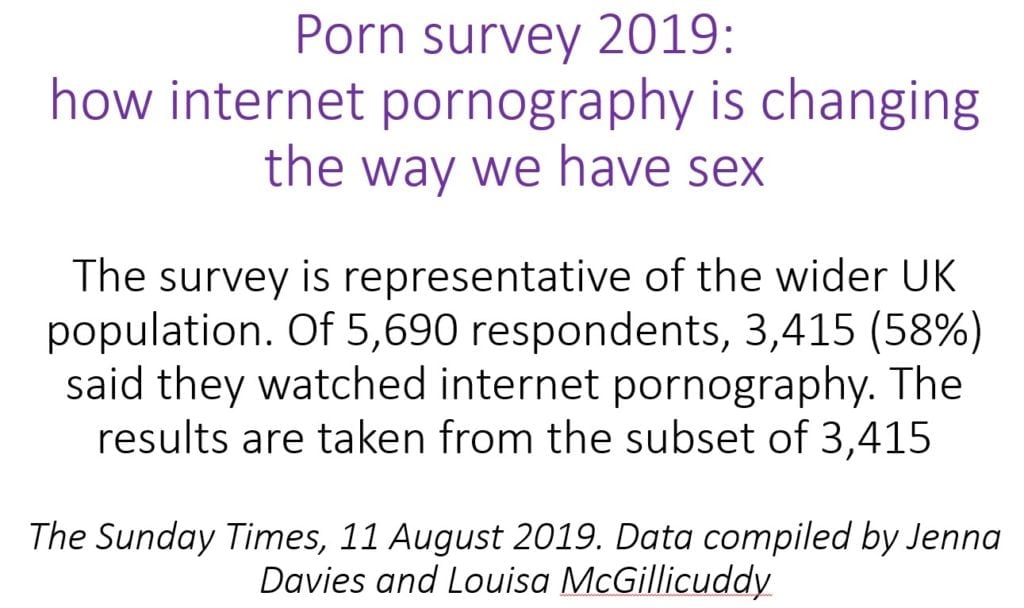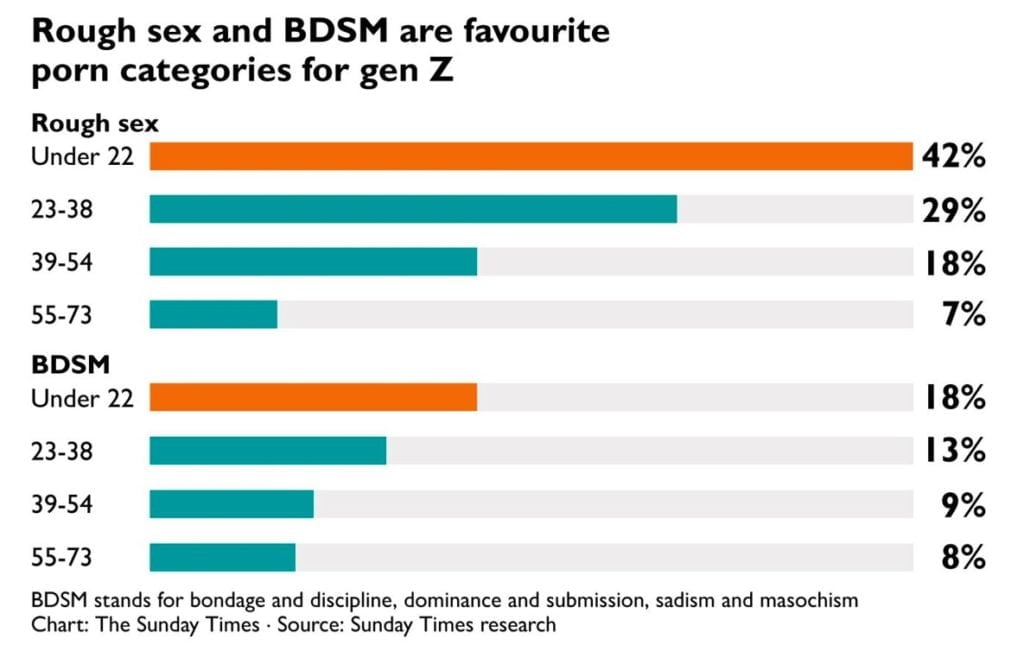Many of the unwanted effects of porn are caused by conditioning one’s sexual response to the internet porn’s content and delivery system. Examples include some users’ morphing sexual tastes, porn-induced ED, loss of attraction to real partners (even belief in one’s asexuality), delayed ejaculation, anorgasmia, needing greater stimulation to achieve the same arousal state. For years experts have endeavored to call attention to this phenomenon, and other evidence of sexual conditioning. See for example:
If pornography consumers find pornographic stimulation more arousing and satisfying than sex with their partners, they may struggle to experience orgasm during partnered sex. …
Pornography consumption frequency may be a particularly strong predictor of [orgasm difficulty] among young women.
Although a preference for functional sex with a partner was expressed by participants, our data suggest that masturbation dependence develops as a result of their sexual response having become conditional on a discrete set of behaviours, and is reinforced by cognitive components displaying different characteristics during masturbation and partner sex.
Given that our [patients] reported that they experienced erections and arousal with Internet pornography, but not without it, research is needed to rule out inadvertent sexual conditioning as a contributing factor to today’s rising rates of sexual performance problems and low sexual desire in men under 40.
Addictive masturbation, often accompanied by a dependency on cyber-pornography, has been seen to play a role in the etiology of certain types of erectile dysfunction or coital anejaculation. It is important to systematically identify the presence of these habits rather than conduct a diagnosis by elimination, in order to include habit-breaking deconditioning techniques in managing these dysfunctions.
Sexual conditioning:
Several participants who reported no known pre-existing sexual interest in children prior to viewing CP believed that repeated exposure to these materials essentially ‘conditioned’ them to develop a sexual interest in children.
Since nearly all participants reported no desire to engage in contact sexual offenses, it is possible that this process conditioned participants to develop an interest in CP, rather than in children themselves (and by extension child sexual abuse). Participants provided varying descriptions of how they perceived this conditioning process:
It’s kind of like … when you have your first sip of gin, or whatever. You think, ‘this is horrible’, but you keep going and eventually you start to like gin. (John).
The circuits in my brain that were related to sexual arousal, the circuits that were firing when I was looking at pictures of children … years of doing that probably caused things in my brain to change. (Ben)
As their interest in CP increased, participants who had previously viewed both adult and child pornography reported finding it increasingly difficult to become aroused to sexual stimuli involving adults.
At face value, this conditioning process may seem contradictory to the experience of habituation described earlier. However, it is important to understand that for people without a sexual interest in children, the conditioning process seemed to occur between the onset of viewing CP and participants’ eventual habituation to these materials.
Study reported that the 18–30 year-old group reported the highest mean of deviant sexual fantasy followed by those 31–50, then those 51–76 years of age. Put simply, the age group with the highest rates of porn use (and who grew up using tube sites) report the highest rates of sexual deviant fantasies (rape, fetishism, sex with children). Excerpt from the discussion section suggests that porn use may be the reason:
Additionally, a possible explanation for why those under 30 years of age endorsed more deviant sexual fantasies than those over the age of 30 could be due to increased pornography consumption among younger men. Researchers found that pornography consumption has increased since the 1970s, rising from 45% to 61%, with change over time being the smallest for older age groups for which pornography consumption decreases (Price, Patterson, Regnerus, & Walley, 2016). Additionally, in a study of pornography consumption among 4339 Swedish young adults, less than one third of participants reported viewing deviant sexual pornography of violence, animals and children (Svedin, Åkerman, & Priebe, 2011).
Although pornography exposure and usage were not assessed in the current study, those under 30 years in our sample could be viewing more pornography, as well as more deviant forms of pornography, than those over the age of 51 years as pornography usage in young adulthood has become more socially accepted (Carroll et al., 2008).
Multivariable negative binomial regressions were used to assess the association between pornography use and any lifetime perpetration of IPV, controlling for gender, age group, race/ethnicity, relationship status, educational status, military rank, hazardous drinking, depression, stimulant use, depressant use, and post-traumatic stress disorder. Of the population analyzed, 41% of soldiers reported any pornography use per week, and 9.6% reported perpetrating any form of IPV. Soldiers who reported pornography use had between a 1.72- and 3.56-fold greater likelihood of reporting any lifetime perpetration of IPV, controlling for covariates.
- The Dual Control Model – The Role Of Sexual Inhibition & Excitation In Sexual Arousal And Behavior (2007)
Some of the male subjects’ erectile dysfunction was,
related to high levels of exposure to and experience with sexually explicit materials.
The men experiencing erectile dysfunction had spent a considerable amount of time in bars and bathhouses where porn was “omnipresent,” and “continuously playing“. The researchers stated:
Conversations with the subjects reinforced our idea that in some of them a high exposure to erotica seemed to have resulted in a lower responsivity to “vanilla sex” erotica and an increased need for novelty and variation, in some cases combined with a need for very specific types of stimuli in order to get aroused.
This study on sexual conditioning in quail shows that males can be sexually conditioned to a substitute for a real sexual partner (a terry cloth object). Interestingly, those who copulate (i.e., “show a consummatory response”) using the object continue to find it arousing, whether or not they have access to regular sexual opportunities with real females.
The conditioned approach behavior of male quail [who copulated with the object] did not show much, if any, decline during the course of extinction trials whether or not the males received access to a female in their home cages during the extinction phase.
Similarly, many men who condition their sexual arousal to artificial stimuli (porn), and later acquire sexual partners, report continued (sometimes even compulsive) use of porn.
Those quail that received no access to females appeared to develop a compulsive use of the object (more frequent copulation). The frequency of their copulation with the object increased significantly. In short, the artificial stimulus became a primary stimulus, akin to a real partner, but apparently less satisfying.
The researchers discuss the implications of their research for masturbation addiction/compulsivity, which is one of the main problem areas in CSBD (Compulsive Sexual Behavior Disorder).
If fundamental needs of individuals are not satisfied like relatedness, intimacy and sexual relationship with a loved one, they may resort to substitute satisfaction. Any object or act which may provide an opportunity for sexual consummatory responses may provide sensory reinforcement leading to compulsively engaged masturbatory activity or fetishistic behavior.
…Copulating with the substitute object is not entirely satisfying and does not entirely eliminate the need state. Therefore, the need state of participants in the No female subgroups gradually increases during extinction phase. This in turn results in a corresponding increase in conditioned copulatory responses to the [substitute, conditioned stimulus]. Our model predicts that this escalation of sexual [consummatory responses, copulations] will be only observed if (1) animals are deprived of a biologically significant [stimulus] (live female), (2) the deprivation creates an increasing need for that [stimulus], and (3) there is a substitute object that participants can copulate with to reduce their need state.
Histories of abuse do appear to be particularly common in pedophiles who prefer boy victims. The members of this group have a number of characteristics that distinguish them from other sex offenders. Their deviant behavior often has an early onset, they may lack any significant interest in consenting sexual relations with adults (this is the group that Groth describes as “fixated” offenders), their behavior is often extremely compulsive and resistant to treatment, and they tend to have many victims. In one series, a group of 146 homosexual pedophiles at large in the community had committed an average of 279 assaults each. Impressionistic reports from several treatment programs indicate that while psychiatric diagnoses of any kind are uncommon in this group, sexual abuse histories are particularly common, ranging from 40 to 60 percent. In one out- patient treatment program, the staff estimated that 55 percent of the child molesters had been victimized, most commonly by male baby- sitters. They further observed that young men who raped women did not appear to have unusually frequent abuse histories, but that young men who raped men were almost uniformly victims of sexual abuse. Taken together, these data suggest the possibility that child- hood sexual trauma in boys may be a particularly significant risk factor for the development of sexually abusive behavior directed at males. The cycle of abuse theory may turn out to have some prediction power for this population.
It is each animal’s unique experience with sexual behavior and sexual reward that molds the strength of responses made toward sexual incentives.
Somatosensory cues [such as wearing a rodent jacket during early sexual encounters] can signal sexual excitation or inhibition in male rats depending on the conditioning history.
SEM [sexually explicit media] consumption was found to be significantly associated with sexual risk behaviors. Participants with increased consumption of bareback SEM reported higher odds of UAI [unprotected anal intercourse] and I-UAI [insertive anal intercourse] after adjusting for other factors using multivariable statistics.
Experience, not childhood or genes, configures individual reward-circuit wiring. This remarkable finding places in doubt many long held assumptions. In short, addiction is NOT largely inherited, sexual tastes are NOT set in stone, and experiences have a major impact on this ancient brain circuit. Does this mean that what we condition our sexual arousal to can shape future tastes? It appears so.
“Intriguingly, the pleasure centre and the behaviour it guides are sculpted mostly by life experiences rather than by our genes. This challenges previous assumptions that dopamine function could be straightforwardly inherited.” —Paul Stokes, MD, PhD
A Safron, V Klimaj
Limited heritability demonstrates that orientation cannot be completely determined by genetic factors.
…the intensely pleasurable nature of sexual activity implies that reward learning can have profound impacts on sexuality (Hoffmann & Safron, 2012). Indeed, some have argued that classical and operant conditioning may be the central means by which adult sexual preferences are established in humans as well as other species.
…these differences could also result from brain plasticity—the brain’s ability to change itself through experience—rather than being caused by organizational effects of sex hormones
…Over time, accumulated conditioning could produce relatively stable preferences
…When a sufficient degree of conditioning has taken place, these stimuli may drive habitual thought patterns, fantasies, and eventually behaviors, all of which may produce additional experiences of reinforcement. And due to differences in genital arousal dynamics described above, men may be more likely to experience this ‘critical mass’ of conditioning within critical windows of developmental plasticity
…Initial schemas and scripts set the stage for later developments (Pfaus et al., 2012), and thus the conditions surrounding early sexual experiences are more likely to have this ‘first-mover’ advantage in shaping erotic development. Furthermore, the sooner a learning process begins in development (Safron, 2019), the more time it has to operate and thus accumulate a more extensive history of conditioning. Moreover, early experiences can take advantage of the greater plasticity of young brains, which are still in a period of dynamic alteration due to factors such as changing hormones, progressive myelination, and ongoing neuronal and synaptic pruning
…genital arousal acts as a powerful and reliable conditioning stimulus that amplifies preferences such that they may become enduring orientations.
…Pfaus and colleagues have demonstrated that numerous aspects of mating behavior can be shaped by experience, and that initially non-sexual stimuli can become sexually rewarding through conditioning. Examples of sexual conditioning range from rats with “fetishes” for the velcro-jackets they wore during early sexual experiences, to rats that desire the smell of the initially unconditionally aversive odor of cadaverine. These mechanisms of sexual imprinting have been observed in numerous other species as well
Although recent experimental demonstrations of human sexual conditioning are neither numerous nor robust, sexual arousal showed to be conditionable in both men and women.
The current state of literature indicates that the RDoC- positive valence systems are important factors in PPU. For reward anticipation, the evidence indicates incentive sensitization towards stimuli announcing sexual rewards in patients with PPU, but it is still unclear which situational factors contribute to this process. Similarly, most studies found increased initial response to reward, as shown in neural responses and attentional/approach biases to sexual rewards associated with PPU symptoms. This could be due to patients’ prior learning history with these rewards. Reward valuation studies reported an increased differentiation of sexual reward values associated with PPU. This might reflect heightened sensitivity to sexual reward value information which could be a precursor or consequence of PPU. Finally, reward learning studies have shown increased conditioned responses to stimuli associated with sexual reward in classical conditioning paradigms.
Porn survey 2019: how internet pornography is changing the way we have sex


The many studies suggesting escalation in some porn users may be relevant here too. See Over 50 studies reporting findings consistent with escalation of porn use (tolerance), habituation to porn, and even withdrawal symptoms.
These articles may also be of interest:
- We Can’t Consent To This. The horrifying harms of choking – new research
- Are Sexual Tastes Immutable?
- First Sex: Just The Science Please
- Can You Trust Your Johnson?
- Wiring Sexual Tastes to Hairless Genitals…Oops!
- New Finding Calls Into Question Assumptions About Sexuality
- Young Porn Users Need Longer To Recover Their Mojo
